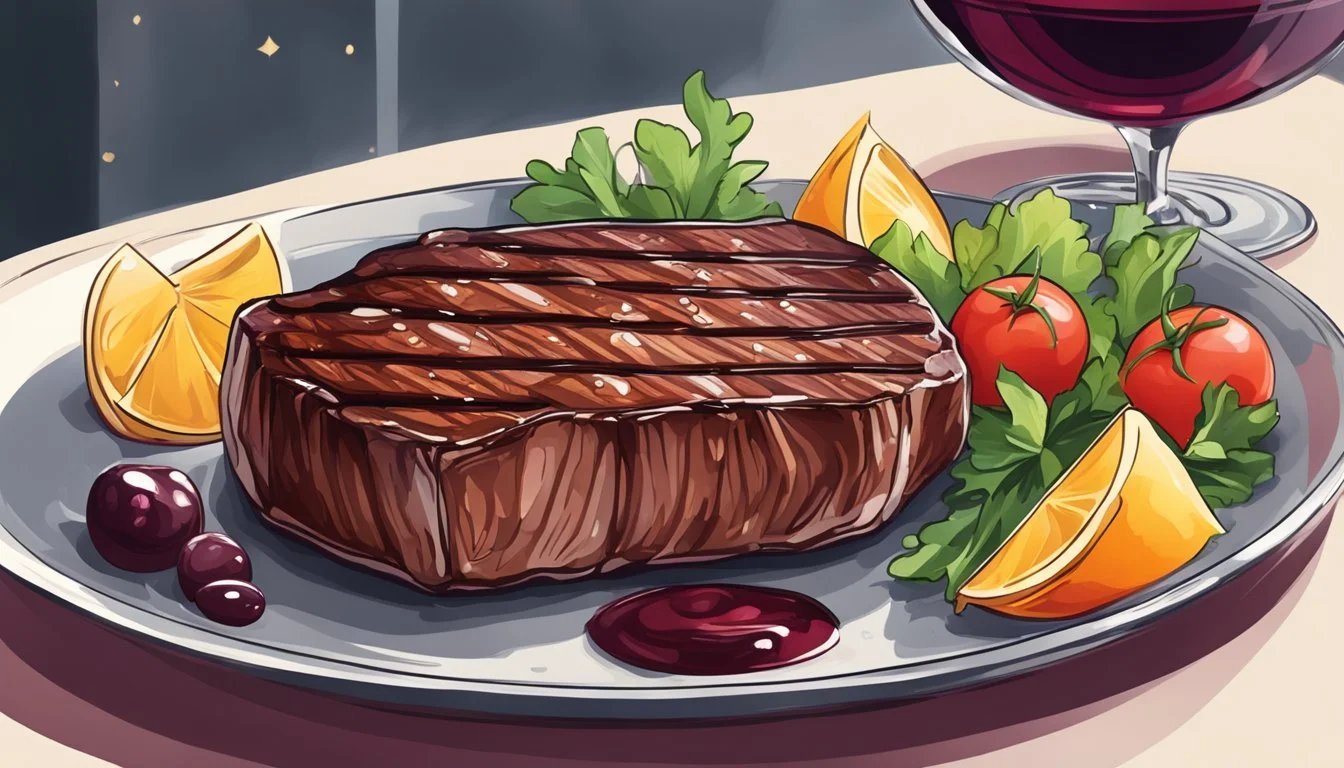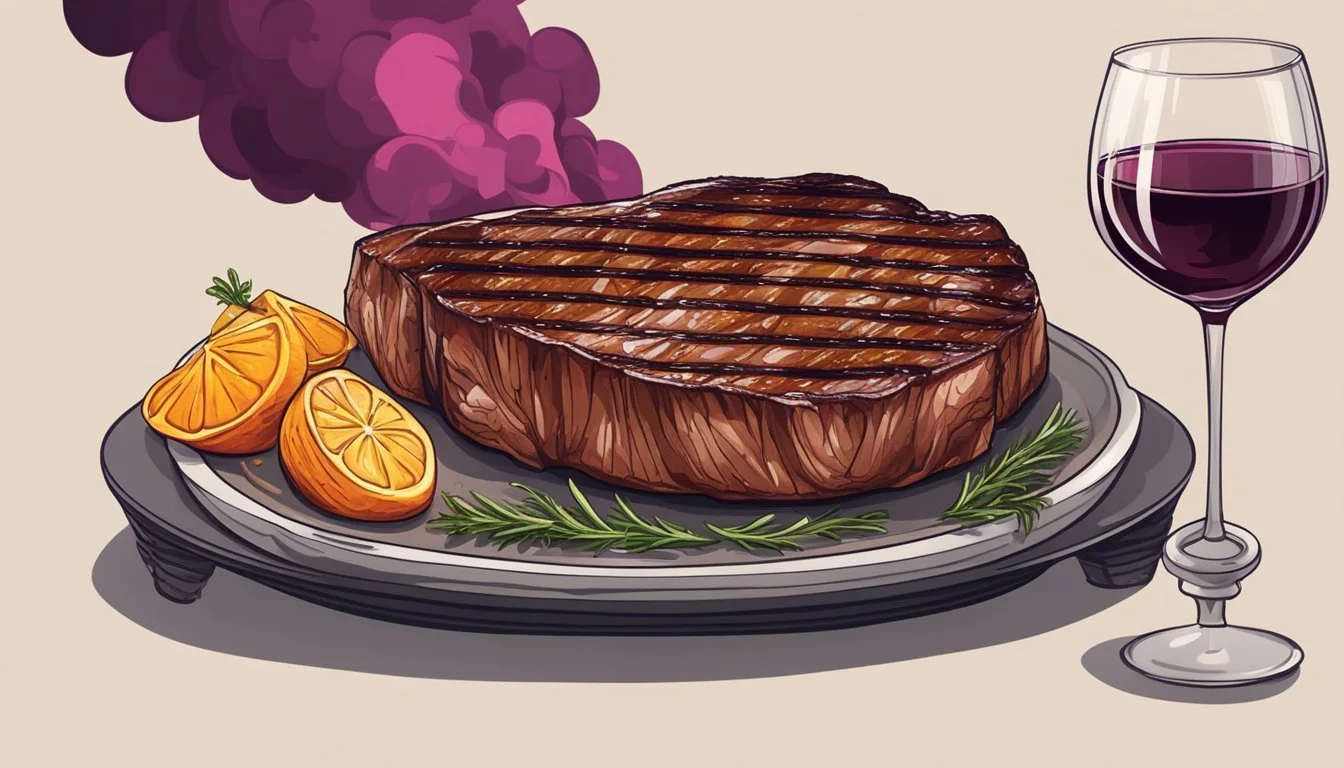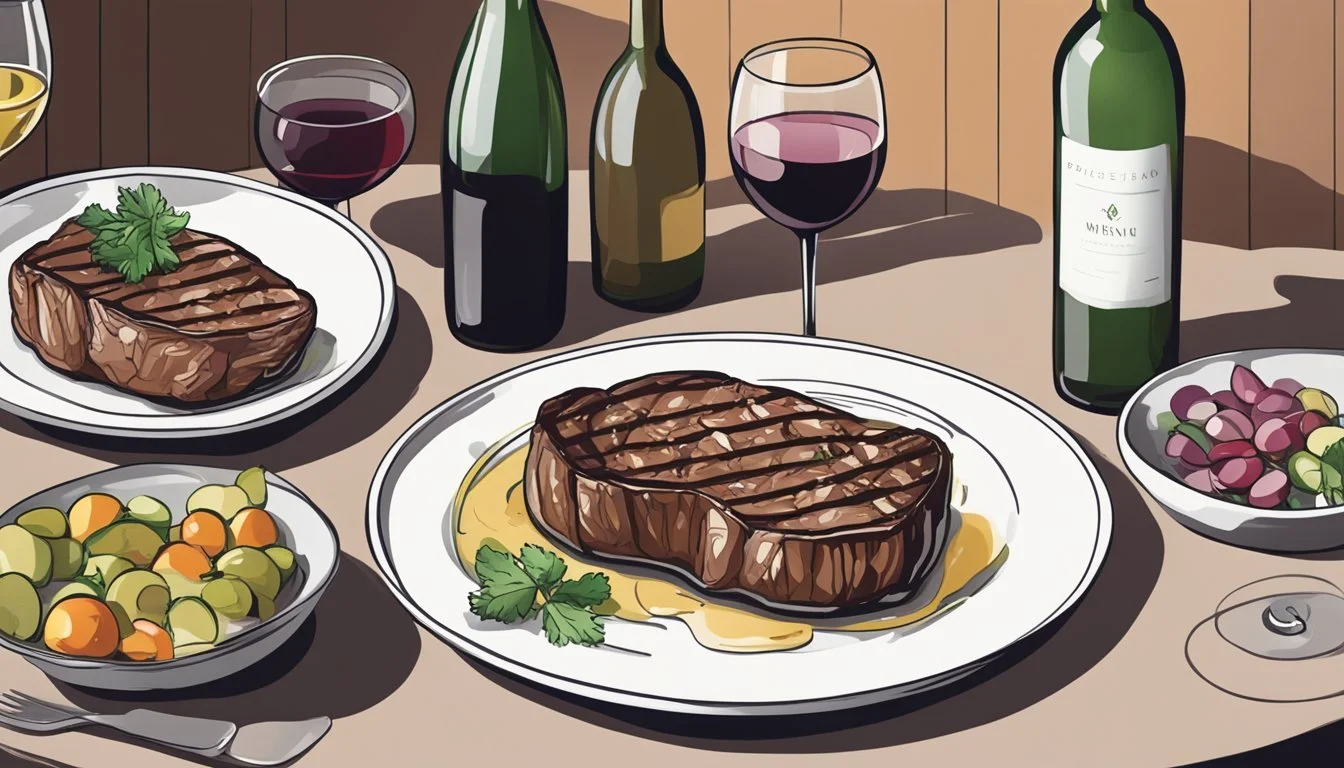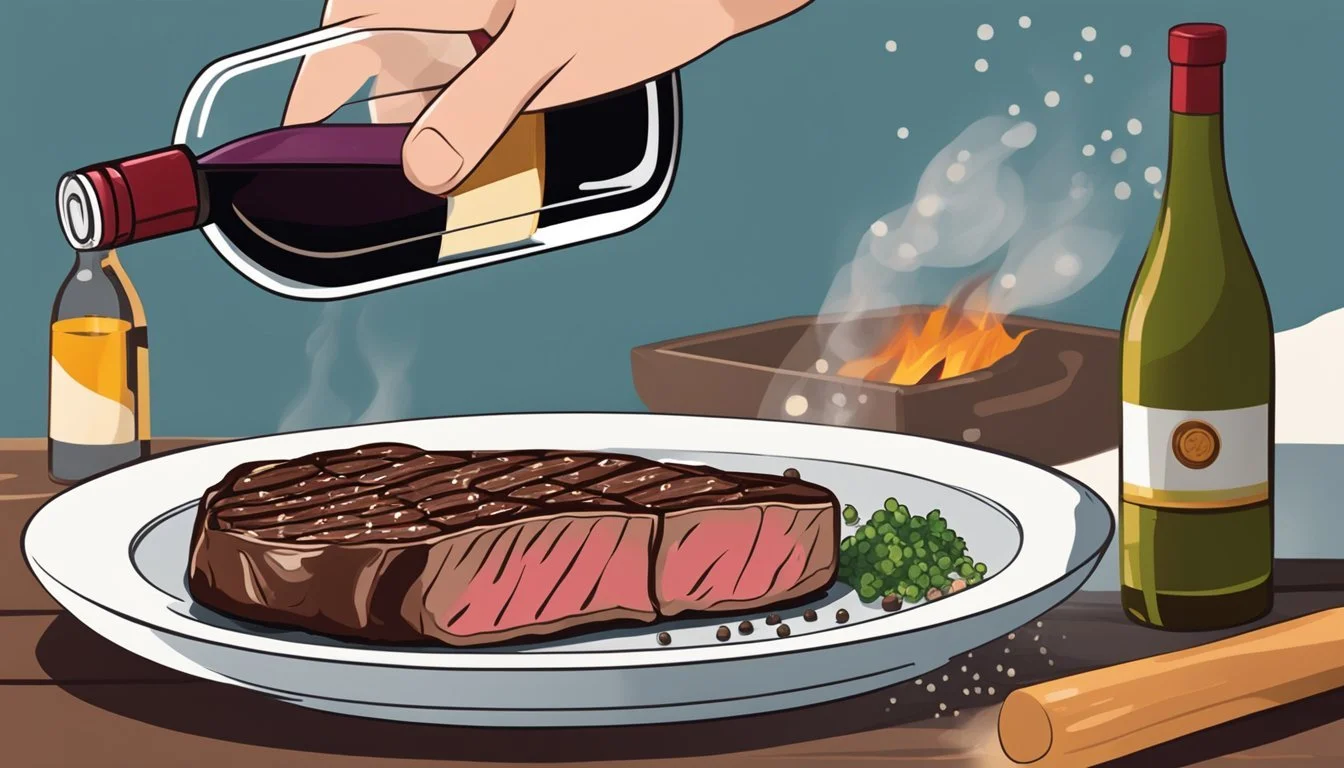What Wine Goes Well With Sirloin Steak?
Your Guide to Perfect Pairings
Selecting the perfect wine to accompany a sirloin steak (What wine goes well with sirloin steak?) elevates the dining experience, offering a harmonious interplay of flavors and textures. Sirloin, known for its robust beefy taste and slightly firmer texture, pairs exceptionally well with wines that feature a balance of tannins and acidity. The classic choice for such a pairing is a Napa Valley Cabernet Sauvignon, which is celebrated for its full-bodied profile and complementing flavors of black fruit, including black currant, along with hints of smoke, vanilla, and sometimes butter.
The structure of these wines, with their substantial tannins, stands up well against the richness of the sirloin. The natural tannins in red wines act as palate cleansers, cutting through the fat and protein of the steak, which makes each bite as flavorful as the first. The acidity in the wine also plays a crucial role, providing a bright contrast to the meat’s savory notes and enhancing the overall taste combination.
In the quest for the ultimate steak and wine experience, it's not just about selecting any red wine; it's about choosing one with the right characteristics to match the specific cut of beef. A well-chosen wine not only complements the meal but also brings out the subtle qualities of both the steak and the wine, creating a sophisticated and enjoyable dining experience.
Understanding Steak and Wine Pairings
Choosing the right wine to complement a sirloin steak hinges on recognizing how elements like tannins and acidity interact with the meat's texture and fat content.
The Importance of Tannins and Acidity
Tannins are compounds in red wines that lend a dry, puckering quality. This trait is key in pairing with a sirloin steak, as tannins help to break down the steak's fat, enhancing both the meat's flavor and texture. Acidity in wine cuts through fat and balances the robust flavors of the steak. Wines with higher acidity, like certain reds, can cleanse the palate and make each bite of steak as satisfying as the first.
Factor of Fat in Steak
The fat content in a sirloin steak contributes to its succulence and flavor. When selecting a wine, one should consider a vintage with enough tannins to match the fat level of the steak. A red wine with medium to high tannin content can effectively interact with the fat, enriching the overall dining experience.
Significance of Steak Cut
The cut of steak is a pivotal factor in wine pairing. Sirloin, known for its balance between lean meat and a flavorful fat edge, demands a wine that offers a similar balance. The texture of the sirloin is less marbled than other cuts, which typically pairs well with medium-bodied red wines that boast a balance between tannins and acidity. These wines should complement the meat's texture without overwhelming its natural flavors.
Selecting the Right Red Wine
When choosing a red wine to accompany sirloin steak, one should consider wines that complement the flavor and texture of the meat. Sirloin, known for its robust flavor and generally leaner profile, pairs best with red wines that offer a balance between fruitiness and tannins.
Popular Red Wines for Sirloin
Cabernet Sauvignon: A classic choice, known for its ability to pair well with sirloin due to its high tannin content and full-bodied nature.
Merlot: Softer than Cabernet, it matches the steak’s flavor without overpowering it.
Malbec: Offers a rich and fruity profile that enhances grilled sirloin.
Syrah: Its spicy notes can complement the char on a grilled steak.
Zinfandel: The bold fruit flavors can stand up to the strong taste of sirloin.
Characteristics of Cabernet Sauvignon
Cabernet Sauvignon is distinguished by its:
Body: Full-bodied
Tannins: High tannin levels
Flavor Profile: Dark fruits, such as black cherry, and often a hint of spice or oak
This varietal's structure helps cut through the richness of the sirloin, making it a top pairing choice.
Merlot and Its Affinity for Sirloin
Merlot is characterized by:
Body: Medium-bodied
Tannins: Moderate tannins
Flavor Profile: Red fruits like cherries and plums, with a smooth finish
This wine's velvety texture harmonizes with the tenderness of sirloin, offering a balanced pairing.
Exploring Other Red Varietals
While Cabernet Sauvignon and Merlot are popular, other reds also offer appealing pairings:
Malbec: Full-bodied, with a plummy fruit profile, well-suited to the char of grilled sirloin.
Syrah: Offers peppery and meaty notes, echoing the savory aspects of the steak.
Zinfandel: Its bold fruit and spice can pair with well-seasoned sirloin, matching the steak's intensity.
The Role of Wine Regions
Selecting the right wine to accompany a sirloin steak can be significantly influenced by the region where the wine is produced. Different terroirs and winemaking techniques contribute to the final flavor profile of the wine, which in turn affects how well it pairs with the meat.
Napa Valley and Bordeaux Influences
Napa Valley, located in California, is renowned for its Cabernet Sauvignon—a wine that is robust in tannins and exudes flavors of dark fruit and oak. These characteristics make it an excellent companion for the rich texture of sirloin steak. Similarly, the Bordeaux region of France is a prestigious wine-producing area, where blends dominated by Cabernet Sauvignon and Merlot offer a structured palate with notes of black currant and cedar that stand up well to the savory sirloin.
Argentina's Malbec
Over in Argentina, Malbec has risen to be the signature varietal, especially from regions like Mendoza. Argentine Malbec typically presents a fruit-forward profile with a velvety texture. The plush, ripe berry flavors of Argentine Malbec balance the robust nature of sirloin steak, creating a harmonious dining experience.
Old World versus New World Styles
When considering Old World wine regions, such as Bordeaux, the Rhône Valley, or Rioja, the wines are often more subtle and terroir-driven with higher acidity and earthy notes. These wines can complement the umami flavors of a sirloin steak without overpowering it. On the other hand, New World regions like Napa Valley, some areas of Australia, and Argentina produce wines that are typically fruitier and more intense, which can hold their own against a well-seasoned steak.
Flavors and Aromas
When selecting a wine to pair with sirloin steak, one should consider how the wine’s flavor profiles and aromas will complement the rich and diverse tastes of the meat.
Matching Flavor Profiles
A well-chosen wine can mirror the inherent flavors of sirloin steak, providing a harmonious dining experience. A sirloin typically has a bold and slightly lean quality, with less fat than other cuts. Wines with a full body and rich notes of black fruit such as black currants and cherry blend seamlessly with the steak's natural juiciness. Varieties like Napa Valley Cabernet Sauvignon not only align with these flavors but also introduce complementary undertones of vanilla and butter, especially if the steak is cooked with butter.
Enhancing the Taste Experience with Aromas
The aroma of a wine can enhance how one perceives the taste of steak, creating a more layered eating experience. Wines with oak-influenced aromas add a dimension of smoke and spice to the meal. Subtler notes of pepper, tar, and herbs found in certain red wines, like a spicy Shiraz, may accentuate any char or seasoning on the steak.
For diners who enjoy a sauce with their sirloin, a wine’s secondary flavors such as coffee, chocolate, or fruit can enhance even the most robust sauces. The tannins in red wine cut through the richness of both the meat and the sauce, making for a balanced dining experience.
Advanced Pairing Concepts
The right wine can elevate the flavors of a sirloin steak, with the wine's aging and structure playing pivotal roles in the pairing.
Impact of Aging on Wine and Pairing
Wine aging profoundly affects a wine's balance and intensity, making it either a harmonious or discordant match for sirloin steak. Aged wines generally have a mellowed tannin structure and enhanced richness, which complement the robust flavors of the beef. For example, a sirloin steak with a complex flavor profile pairs well with a mature Bordeaux blend, where the softened tannins and evolved complexity can match the steak's richness without overpowering it.
Understanding Wine Body and Structure
The body and structure of a wine are determined by factors such as grape variety, alcohol content, and winemaking techniques, all of which contribute to the wine's overall intensity and mouthfeel. A full-bodied wine with firm tannins is traditionally recommended for sirloin steak due to the cut's moderate fat content and substantial texture. The wine's body should neither overpower the meat's flavor nor be too light to handle its richness.
Body: Full-bodied red wines exhibit a higher level of alcohol and a richer mouthfeel, providing a weight that can stand up to the texture of sirloin steak.
Structure: The tannins in red wine interact with the proteins in the steak, helping to cleanse the palate between bites; a well-structured wine with balanced tannins is crucial for a pleasant pairing experience.
In selecting a wine for sirloin steak, one might consider options like a Shiraz with its bold structure or a Malbec for its balance between fruit intensity and tannin presence. The structural components of the wine should harmonize with the steak's flavor profile to enhance the dining experience.
Alternatives to Red Wine
While red wine is traditionally paired with steak, certain white wines and rosés can present a refreshing contrast to the richness of sirloin steak when chosen carefully.
When to Choose White or Rosé
For those who prefer lighter wines or seek a contrast to the robust flavors of sirloin steak, Chardonnay and Riesling can be excellent choices. Chardonnay, with its full body and often buttery notes, can complement butter-basted sirloin steak. Meanwhile, an off-dry Riesling works well with grilled sirloin, especially those marinated in sweet or spicy sauces, as its sweetness and acidity can balance the flavors.
Chardonnay: Full-bodied with buttery notes; pairs with butter-basted steak.
Riesling: Off-dry, sweet, and acidic; balances spicy marinades.
A well-chilled rosé can offer a palate-cleansing effect. They are versatile with food and can support the lighter flavors of a lean sirloin without overpowering it. One must opt for rosés with enough body and acidity to stand up to the meat.
Rosé: Versatile, palate-cleansing, with body and acidity.
Pairing Steak with Sparkling Wines
Sparkling wines, including Champagne, offer a unique pairing experience with sirloin steak. The effervescence and acidity of Champagne can slice through the richness of the dish, making it an unconventional yet delightful accompaniment. Brut Champagne, with its dryness and crispness, is especially effective in refreshing the palate.
Champagne: Effervescent, acidic; cuts through richness with its dry, crisp nature.
In summary, when one is inclined to stray from the rich tannins of red wine, these white and sparkling alternatives provide a sophisticated means to complement the savory succulence of sirloin steak.
Cooking Techniques and Seasoning
The success of a wine pairing depends significantly on how the sirloin steak is prepared and seasoned. Cooking methods such as grilling or pan-searing, as well as the choice of seasonings and sauces, greatly influence the flavor profile and ultimately the choice of wine to accompany the dish.
Grilled versus Pan-Seared Sirloin
Grilled Sirloin:
Grilling imparts a smoky flavor and often a desirable charred exterior to the sirloin, which complements robust wines with a similarly bold character.
Ideal pairings: Full-bodied reds with smoke or oak notes.
Pan-Seared Sirloin:
Pan-searing provides a caramelized crust with a tender interior, highlighting the meat’s natural flavors and pairing well with a variety of wines.
Ideal pairings: Medium- to full-bodied red wines with balanced tannins.
Choosing the Right Seasonings and Sauces
Seasonings:
A basic rub of salt and pepper enhances the natural taste of the sirloin without overwhelming the palate, allowing more delicate wines to shine through.
For bolder seasonings, select wines that can stand up to intense flavors without being overpowered.
Sauces:
Chimichurri sauce, which often contains garlic, parsley, and cilantro, adds a fresh herby accent that can be nicely offset by a wine with herbal or green notes.
Creamier or heavier sauces may necessitate a wine with good acidity to cut through the richness.
Pairing Wine with Different Steak Cuts
Matching wine with steak requires consideration of the cut's texture, fat content, and preparation technique. Each type of steak cut offers a unique profile that pairs best with certain wines, enhancing the overall dining experience.
Sirloin and Its Unique Profile
Sirloin, particularly top sirloin, is a leaner steak cut prized for its beefy flavor. This lean quality means that tannic wines may overpower the steak, so a medium-bodied wine is preferable. For top sirloin, a Merlot with its moderate tannins and fruity notes complements the steak without competing with its flavor profile.
Preferred Wine Pairings for Sirloin:
Merlot: balances with sirloin’s richness while not overwhelming it
Shiraz/Syrah: the peppery notes harmonize with the natural flavor of the beef
Wine Pairings for Ribeye and Filet Mignon
Ribeye is known for its generous marbling and rich taste, which is best accented by a full-bodied red wine. A Cabernet Sauvignon, with its bold tannins, harmonizes well with the fat content of the ribeye, enhancing the succulence of the meat.
Ribeye:
Cabernet Sauvignon: complements the cut's marbling with its sturdy tannins
Bordeaux Blend: offers a complex flavor that stands up to ribeye's intensity
Contrastingly, filet mignon is a tender and lean option, which calls for a wine that respects its delicate flavor. Pinot Noir, being lighter in body with elegant tannins, is an ideal match for filet mignon as it doesn't overshadow the cut's subtle tastes.
Filet Mignon:
Pinot Noir: enhances the steak's tenderness without overpowering it
Chianti: the wine's acidity cuts through the richness, balancing the tastes
Strip, Porterhouse, and Other Cuts
The New York strip balances flavor and tenderness, making it a versatile cut for various wine pairings. Classic reds like Cabernet Sauvignon or a smooth Zinfandel complement the strip's rich beefy notes and moderate fat content.
New York Strip:
Cabernet Sauvignon: an all-time classic pairing for its robust body and tannic structure
Zinfandel: its fruit-forward taste pairs well with the steak’s flavor complexity
Porterhouse is a larger cut that includes a portion of tenderloin and strip, offering a mixed texture that is both flavorful and succulent. A bold wine such as a Syrah or Prats & Symington Chryseia can match the Porterhouse's richness and multifaceted texture.
Porterhouse:
Prats & Symington Chryseia: a big and bold choice, matching the steak's intensity
Syrah/Shiraz: spicy undertones complement the Porterhouse's complex flavors
Other notable steak cuts like T-bone, flank, and skirt also have their unique characteristics. The T-bone is similar to the Porterhouse and benefits from robust wines like Malbec or Bordeaux blends. Flank and skirt are leaner and often marinated, making them well-suited for aromatic wines like a Rioja or an aged Tempranillo, which can stand up to the bold flavors introduced through marination.
Final Thoughts
Selecting the perfect wine to accompany a sirloin steak is an art that enhances the quality of the dining experience. By understanding the key principles of pairing and striving to elevate the meal, diners can transform a simple dish into a culinary event.
Summary of Key Pairing Principles
Sirloin Steak: A lean but flavorful cut of protein, requiring wines that can complement its texture and taste.
Wine Selection: For sirloin, a high-quality red wine with a balance of body and tannin tends to be most harmonious.
Pairing Guide:
Steak Preparation Wine Suggestion Rare to Medium Medium-bodied red wines Well-done Lighter reds or rich rosés
Elevating the Dining Experience
Pairing sirloin steak, a relatively lean cut known for its versatility, with the right wine should both respect the prime quality of the meat and amplify its natural flavors. A well-chosen wine acts as a palette cleanser, readying the taste buds for the next bite and thus deepening the gastronomic pleasure. Consider the following for an optimal experience:
Serving Temperature: Serve red wines slightly below room temperature to accentuate their character.
Wine's Age: Mature wines often provide a complexity that young wines may lack, offering a more nuanced pairing.







